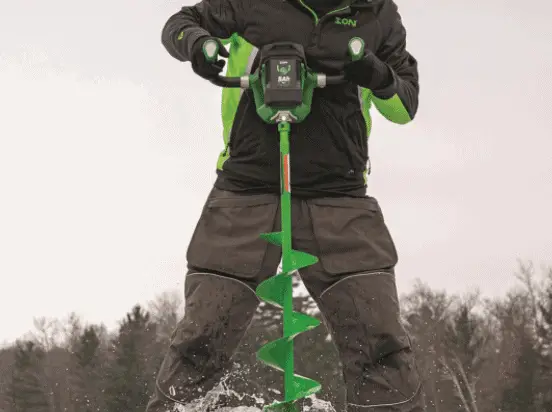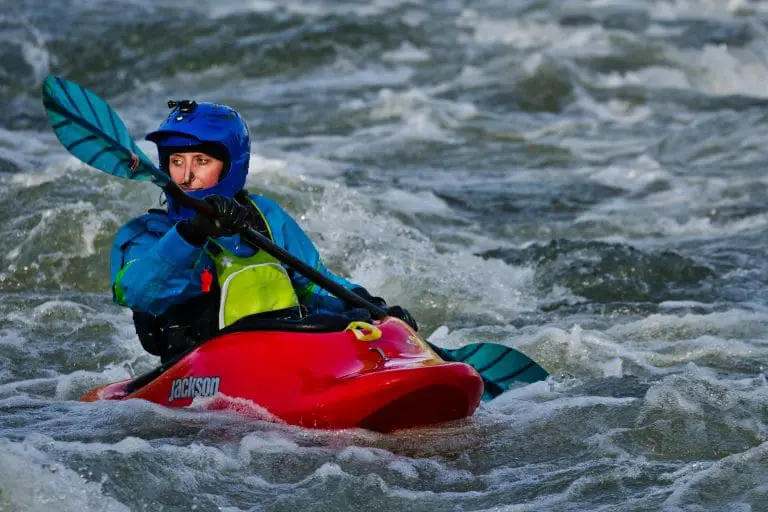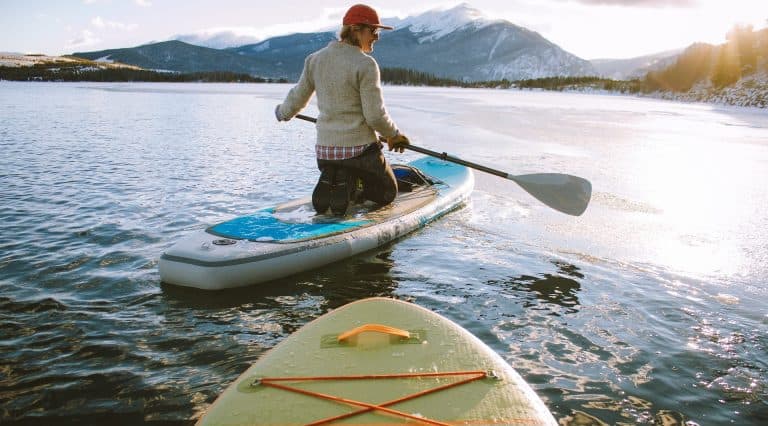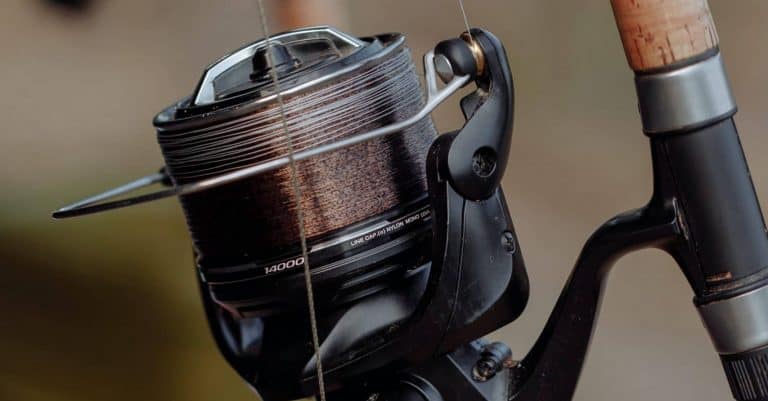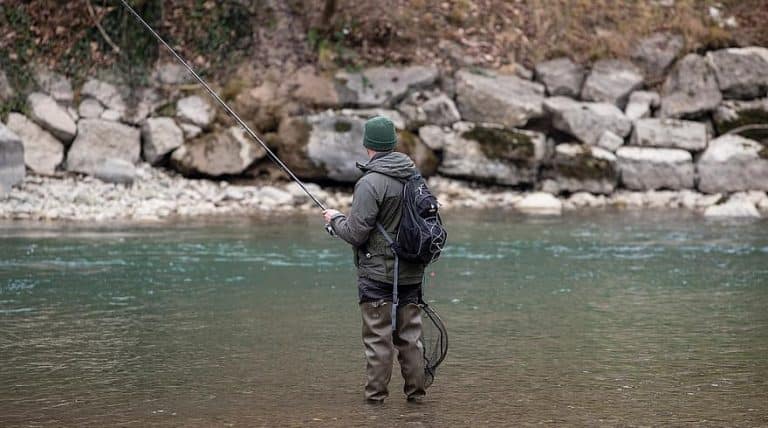8 Best Inflatable Kayaks [Product Reviews & Guide]
Kayaking is a wonderful water sport that is growing year on year. Originally created by the First Nation people of Canada as a way to travel and fish, it is currently used by many people around the world to… travel and fish.
But kayaking is much more than that: it’s a great way to get some fresh air, exercise, spend time with your friends, family, or significant other – or just by yourself – and maybe explore your local rivers and lakes.
We’ve put this guide together to help you find out more about the best inflatable kayaks, and work out if they’re the right option for you.
Best Inflatable Kayaks at a Glance
- Advanced Elements Tandem Inflatable Kayak (Best Inflatable Tandem Kayak)
- Advanced Elements Sport Inflatable Kayak (Best Inflatable Solo Kayak)
- Intex Challenger K2 Inflatable Kayak (Best Budget Inflatable Kayak)
- Airfusion Evo Inflatable Kayak (Best Inflatable Touring Kayak)
- Intex Excursion Pro Kayak
- Intex Explorer K2 Inflatable Kayak
- Solstice Durango Inflatable Kayak
- Sevylor Quikpak K5
Kayaks can be divided into two categories. They are either hard shell or inflatable.
Both of them are pretty much what they sound like: the hard shell kayaks are usually made from solid plastic and keep their shape.
Inflatable kayaks are blown up like armbands when you want to use them, and then deflated and put into a box or backpack when you’re finished.
This can make them much easier to transport, and they’re usually lighter.
Inflatable kayaks are a much more recent invention, but they’re quickly becoming more popular because they’re convenient. Let’s look through some different options.
Best Inflatable Kayak – 8 Product Reviews
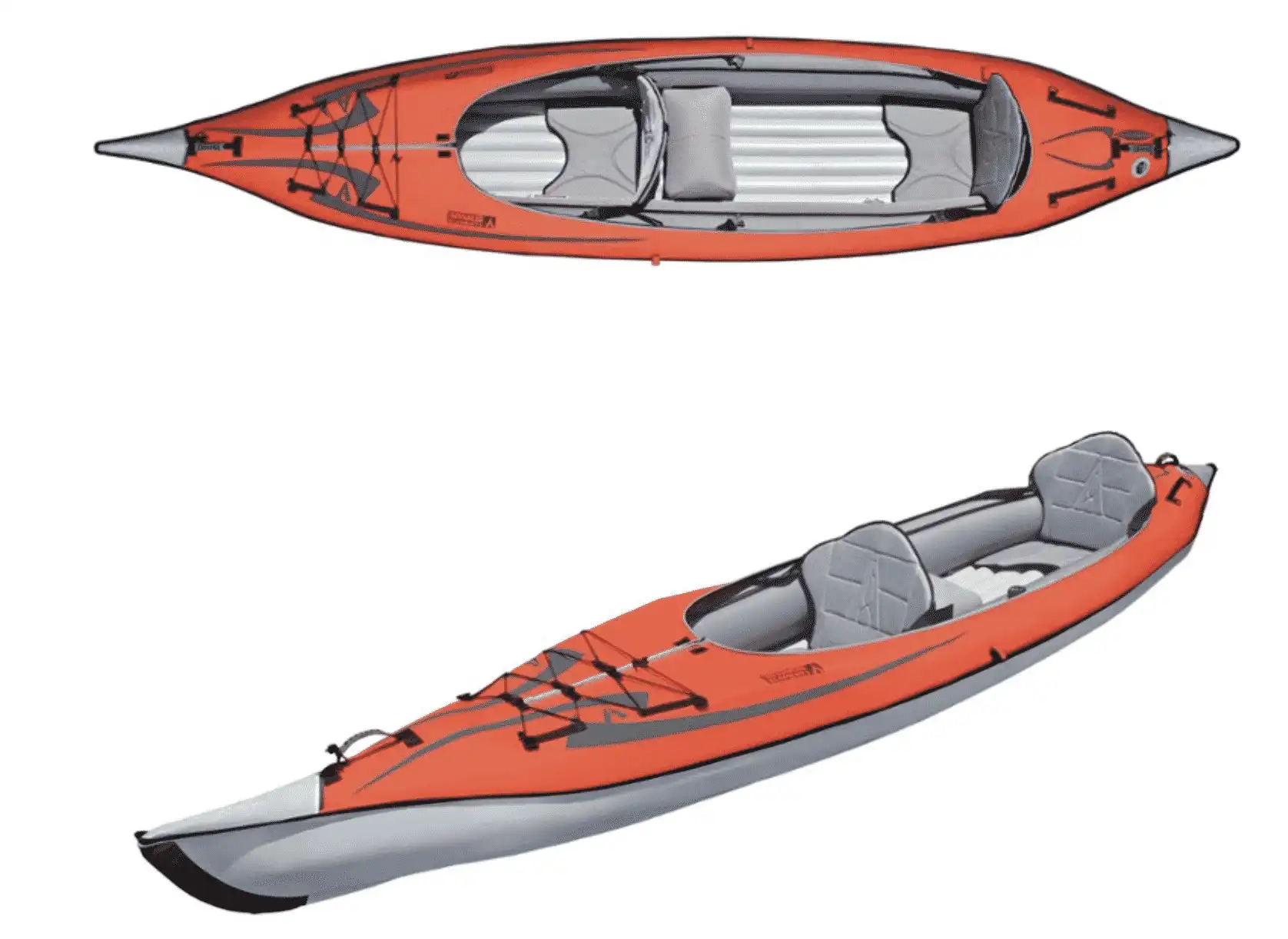 Advanced Elements AdvancedFrame Tandem Inflatable Kayak
Advanced Elements AdvancedFrame Tandem Inflatable Kayak
We’re starting with a tandem kayak. Don’t worry - you won’t have to cycle it! It just means that there’s room for two people in the kayak, which can be great if you like to go out on the water with a friend.
If you’d rather go alone, but for longer trips, this could still be a good choice for you as you don’t have to set up the other seat and can use the additional space for storage. This kayak can be inflated fairly easily with a handheld pump and there are instructional videos available on the company’s website to show you what to do.
As with the other options, we’d recommend practicing at home first. Although this is an inflatable kayak, it does have an aluminum frame that increases its strength and will help you cut through the water when you paddle. This won’t stop you from being able to fold it up when you’re done.
Material: PVC coated polyester
Weight: 52lbs
Length: 15ft
Width: 32in
Load-Capacity: 550lbs
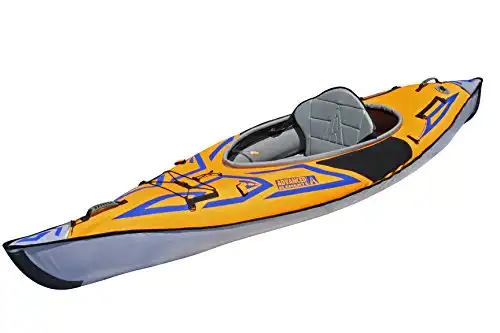 Advanced Elements Advanced Frame Sport Inflatable Kayak
Advanced Elements Advanced Frame Sport Inflatable Kayak
If you’re an experienced kayaker looking for your first inflatable, this could be the right choice for you. It’s designed to work in different kinds of water, so you could take it in white water, out to sea or just on rivers and lakes. This is a sit-in kayak, but it’s still roomy and comfortable. There’s a storage place for snacks, suncream, phones, or anything else you’d like to keep close by. Much like the other Advanced Element Kayaks, there is an aluminum rib frame to help the kayak keep its shape and sit slightly lower in the water, which helps you move more efficiently and stops you from getting blown off course.
There are four air chambers around the cockpit, and it’s easy to inflate and deflate the kayak quickly - great for hitting the water, fast!
And you’re well guarded against punctures with three layers of rip-stop fabric to prevent any damage from rocks, underwater debris, and just general wear and tear from use and setting up.
Material: Aluminium frame & Rip-stop fabric
Weight: 26lbs
Length: 10ft 5in
Width: 2ft 8in
Load-Capacity: 250lbs
Max paddler height: 6ft 2in
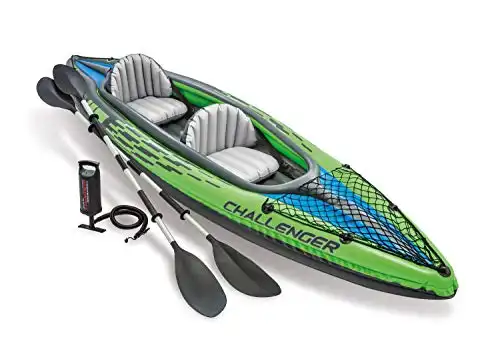 Intex Challenger K2 Inflatable Kayak
Intex Challenger K2 Inflatable Kayak
This is our final two-person inflatable kayak. It’s designed to be sporty, durable, and fun to use with a friend. You can inflate it easily without much practice, and it’s got Boston valves that allow you to inflate and deflate the kayak quickly.
The kayak is made from durable material which should prevent you from getting punctures, but if this does happen whilst you’re on the water you’ll be partially protected because there are two separate air pockets. The ‘floor’ is made with ‘l’ beams to keep it rigid. This serves two purposes: firstly, it means that when you walk or stand up in the kayak it doesn’t fold in on itself and you can stay balanced; and secondly, it helps the kayak cut through the water instead of sitting on top.
Finally, the kayak is bright green, making it easy to spot in emergencies.
Material: Vinyl
Weight: 33.5lbs
Length: 11ft 6in
Width: 2ft 6in
Load-Capacity: 400lbs
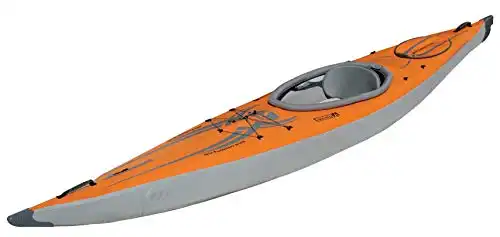 Advanced Elements Airfusion Evo Inflatable Kayak
Advanced Elements Airfusion Evo Inflatable Kayak
This kayak is very different from the other options we’ve looked at. If you’re willing to spend more, and you know that you’re going to do more serious trips and you prefer to have a boat to yourself, this will be good for you.
Unlike the other kayaks, this is a one-person sit-in (so your legs are covered by the boat, which will keep you slightly drier) and it’s much less inflatable - it will pack down, but you’re essentially getting an aluminum frame with polyurethane skin and air pockets. This means that it performs more like a hard shell kayak, which tends to cut through the water instead of sitting on top of it (easier to paddle).
Like the other kayaks, the seat is comfortable and everything (aside from the paddle) will pack down to a duffle bag, which makes it far easier to transport than a traditional hard-shell. You won’t get as much storage space, but there is a small hatch behind the cockpit where you can keep snacks, a camera, suncream, or anything else you might need to keep close.
Material: Aluminium frame & Polyurethane shell
Weight: 32lbs
Length: 13ft
Width: 23in
Load-Capacity: 235lbs
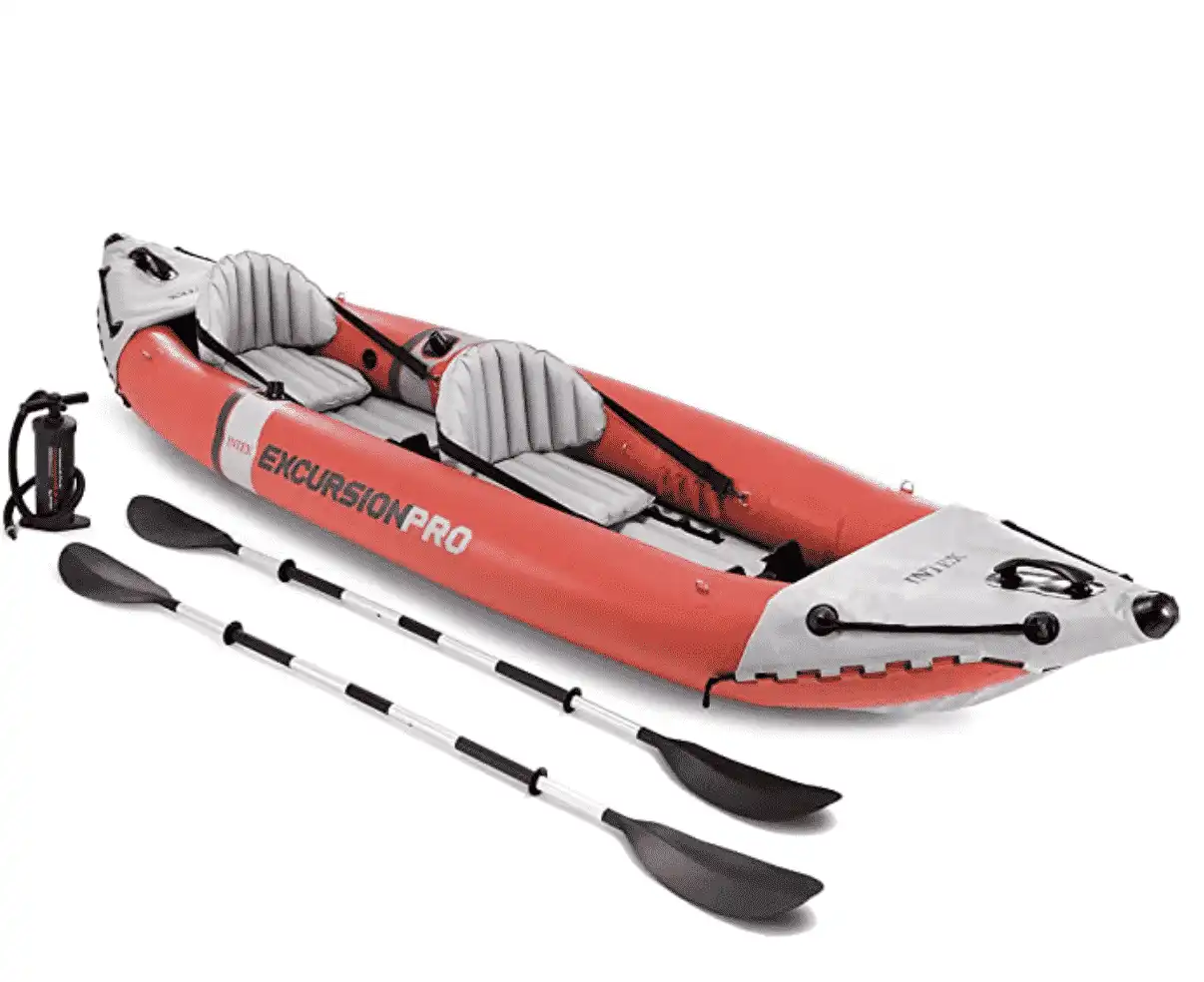 Intex Excursion Pro Kayak, Professional Series Inflatable Kayak
Intex Excursion Pro Kayak, Professional Series Inflatable Kayak
This is another two-person kayak, but like the option above you can switch this to one person and just bring loads of stuff if you prefer. This could work quite nicely because there are adaptations that would make this kayak perfect for fishing. There’s a mounting bracket in front of the seats for a fishfinder or kayak GPS, and footrests to keep you more comfortable if you’re sitting in the kayak for a long period of time.
One of the questions people often have of inflatable kayaks is ‘what if they pop’. Honestly, that’s unlikely to happen, but it is a possibility. To prevent this, manufacturers have developed a tough PVC exterior that won’t be damaged by oil, saltwater, gasoline, sunlight or, abrasions from getting into/out of the water. Over time there may be some wear and tear, so a puncture repair kit is included but both the original material and the cover is designed to be tough and long-lasting, so you get as much use as possible from this kayak.
Material: PVC with a polyester core
Weight: 39lbs
Length: 12ft
Width: 7in
Load-Capacity: 400lbs
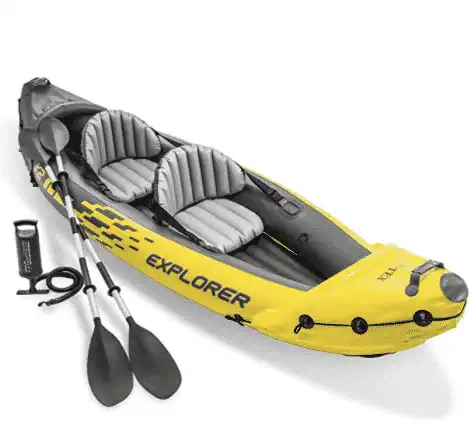 Intex Explorer K2 Inflatable Kayak
Intex Explorer K2 Inflatable Kayak
If you’ve ever been banana boating, you’ll know that it’s a lot of fun but you’ll certainly get wet. This kayak might look like a banana, and be a boat, and be fun - but you shouldn’t fall in the water half as much. And not just because it’s designed to be extremely stable! The yellow is actually so that the boat can be spotted easily in case of an emergency, but it also looks quite nice.
This is another two-person kayak and it’s designed to be comfortable, fun, and suitable for a casual paddler who tends to go for the calm waters of lakes and gentle rivers. You can adjust the seats and they’re designed to be comfortable and great for longer trips. It’s also got Boston valves so it can be inflated and deflated quickly and fairly easily. Much like the other Inte inflatable kayak, this kayak is made from durable materials and should last a long time. If you do get any punctures there’s a patch kit included so you can keep on paddling.
Material: Vinyl
Weight: 30.6lbs
Length: 10ft 3in
Width: 3ft
Load-Capacity: 400lbs
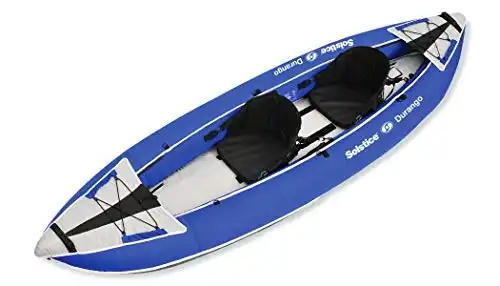 Solstice by Swimline Durango Inflatable Kayak
Solstice by Swimline Durango Inflatable Kayak
This inflatable two-person sit on top kayak is a great choice for anyone who wants something straightforward and easy to use. It’s designed for people who don’t have a lot of experience and are looking to do a bit of paddling, but aren’t especially anticipating days-long trips or to cross anything above a category two rapid. There are Boston valves that allow you to inflate/deflate quickly and easily, and there’s a detachable skeg to keep you cutting through the water nicely.
There’s lots of space, and you can choose what you want to put in it. You have the option to have one or two seats, and you could bring fishing equipment or a picnic. Alternatively, some customers have taken their pet dogs on the water with them and the material holds up fine under their paws. The kayak is made from tough nylon and should be fine with the odd scratch and scrape.
Material: Nylon & PVC
Weight: 29lbs
Length: 11ft
Width: 37in
Load-Capacity: 300lbs
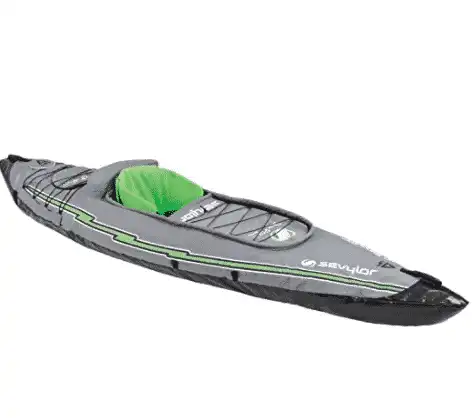 Sevylor Quikpak K5 1-Person Inflatable Kayak
Sevylor Quikpak K5 1-Person Inflatable Kayak
A lot of inflatable kayaks can be put into bags and boxes when you’re done with them. It’s part of their appeal and can make them easy to transport and store.
Our final inflatable kayak folds up into a bag - it literally becomes a bag, with two handy pockets to store the paddle - which also separates into two, smaller parts. This makes it extremely convenient for portaging, or traveling to and from your favorite kayaking spot - you could even take it on the bus!
Aside from that, the Sevylor is a nice one-person sit inside kayak which can be assembled/disassembled in five minutes and has multiple air chambers, and uses tough material to be lake-proof and avoid punctures.
Because it’s inflatable it still sits on top of the water and won’t cut through the same way a hard shell kayak would, which means that it will take more effort to paddle, you won’t go especially fast and you’ll need to be fitter for long trips. However, it is wide, steady, and stable and could work nicely for a casual paddler or someone who is just getting back into kayaking.
Material: PVC and tarpaulin
Length: 10ft
Width: 2.8 ft
Load Capacity: 250lbs
How To Choose The Best Inflatable Kayak
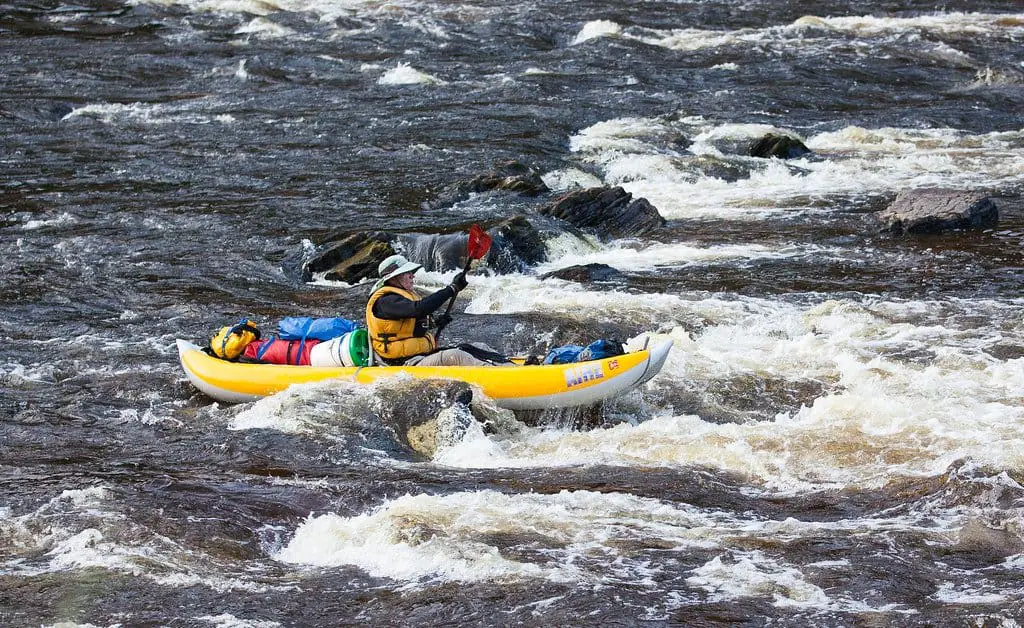
Portability
One of the many advantages of inflatable kayaks is that they’re much easier to move and store than hard shell kayaks. Let’s walk through how a typical kayak trip might work.
Firstly, you’ll need to load up a car or truck with your kayak. For a hard shell that will probably involve hooking a trailer or using a roof rack (although it can be done without a roof rack), which can be expensive, difficult, and heavy.
You may well also need two people unless you’re especially strong or you’re using a lightweight kayak. For an inflatable? Just clear your backseat or boot and put your kayak there in its box. Don’t forget the pump!
Then you drive to the river, lake or sea. If you’ve got an inflatable there won’t be much to think about, but a lot of drivers find transporting hard shell kayaks stressful and worry about them coming off the roof or trailer.
Obviously, you should double-check everything before you drive. When you arrive at the water you’ll either need to inflate your kayak – which, with practice, will take five minutes – or get it off the roof rack/trailer and carry it to the water’s edge. This can be an issue if you’re alone, and you could end up dragging the boat, potentially damaging the edges.
You’re finally on the water. Great! Just don’t think too much about how much effort it’s going to be to reverse all of that and get it home, safely…
There’s no ambiguity here: inflatable kayaks are much, much more convenient and portable. Some kayaks will fold up into their own rucksacks, and others have bags and boxes.
Either way, there shouldn’t be any issue with carrying them by yourself, and it takes away a lot of the planning, extra equipment, and stress.
Durability & Materials
Throughout the history of kayaking, people have been innovating and finding new ways to make kayaks and new materials that improve them. Most hard shells are now made of plastic, but originally First Nation people used wood, bones, and seal skin.
Inflatables are very similar: the idea has stayed the same, but manufacturers have developed different types of PVC, canvas, and other plastics to help you have the best possible experience.
The primary concern when choosing a material for an inflatable kayak is how durable it is. The kayak might be wonderful to paddle, easy to inflate and deflate and pack away nicely but if it pops the second you hit a pebble it simply won’t be a good investment.
Fortunately, manufacturers know this and test lots of different materials. It’s a good idea to think about this when looking at inflatable kayaks, and you should check reviews to see how other customers have got on with their kayaks.
Finally, unfortunately, the best kayaks will eventually get punctures. This doesn’t mean they’re broken and useless forever: you can patch them up and continue using them, like a bike tire!
A lot of the kayaks we looked at earlier come with puncture repair kits or have them available as an optional extra. They should be easy to use, and efficient, and extend the life of your kayak so you can keep on enjoying it.
Storage
One of the most convenient things about the best inflatable kayaks is how easy they are to store. Hardshell kayaks can be left in your garden, but it’s better if they have a bit of shelter, which adds to your ‘kayak accessory’ shopping list (trailer, roof rack, a shelter for storage).
Inflatable kayaks don’t have this problem because they can easily be put away into bags or boxes. Some even fold into their own rucksack, which is even more convenient.
Inflatable kayaks are also smaller and lighter. A hardshell kayak is usually carried by two people – one at the bow, and one at the stern. You can drag them, but that’s a good way to damage the bottom of the kayak and hurt your back. In contrast, putting an inflatable kayak into a bag is usually no more difficult than picking up a tent, and the worst that’ll happen is you might struggle to do the zip up.
Finally, it’s important to make sure that your inflatable kayak is dry when you pack it up. This won’t be possible every time – we’ve all gone kayaking on a sunny day only to have unexpected and heavy rain and ended up leaving in a hurry.
If this does happen, you should dry your kayak off as soon as you can, possibly by spreading it over a washing line. Do not tumble dry! This will mean that your kayak doesn’t go smelly, get mildewed, or damaged from rot.
The materials should be waterproof, but that doesn’t mean that they’re supposed to be constantly wet. Looking after your kayak is the best way to make sure it lasts a long time.
Tandem vs Single
The kayaks we’ve looked at have had room for one or two people. This is fairly standard, and it would be unusual to have more than two people in one kayak. In fact, it’s much more common to have a solo kayak.
There are lots of reasons for this. Firstly, some people just like having a boat to themselves, and find that this is more fun.
You can still go kayaking with more than one person – you just don’t have to share your ‘yak. Also, this keeps the boats smaller and allows you to paddle something that’s less bulky and easier to navigate through narrow spaces.
Some people prefer to have two people in a kayak. This is called a tandem. A lot of people enjoy sharing a boat because it allows them to speak to the other paddler more easily, share snacks and other items, and if you’re paddling for a long period of time you can take breaks and split the work.
Some solo kayakers will also use tandem kayaks, so they can use the additional space to store food, tents, children, or dogs.
Ultimately, it’s not one choice vs the other – it’s what is right for you. If you’re unsure about which to purchase, try hiring some from a local water sports center so you can see if you like to share, or if you’d rather be by yourself.
Inflation
Just compare the two, obviously, hand pumps can be taken anywhere, etc. I will include a product or two here.
The most important thing to take into consideration when choosing a pump is will it work with your kayak.
Otherwise, you’re just wasting your money. A lot of the kayaks on our list will come with a pump included, or you’ll be able to find out which pump is compatible on the ‘suggested extras’ list on Amazon.
However, if you do have the opportunity to choose between the two, you’ll need to think about the following.
Hand pumps are (obviously) more work, and they are usually bigger. If you’re about to spend all day paddling, you probably won’t want to waste energy getting the kayak ready. Plus, they take more time.
On the other hand, electric pumps are faster, but they will need either batteries or to be plugged into an electricity supply.
If you’re at a campsite or at home this should be fine, but if you’re somewhere more isolated this could be a problem. If you do choose to use a battery-operated pump, it’s worth bringing a spare set of batteries in case the original ones run out.
Inflatable vs Hardshell
As inflatable kayaks become more popular, more kayakers are trying them and leaving traditional hard shells behind.
However, many people eventually find a favorite and eventually commit to one or the other with an actual purchase. Let’s look at the key differences, advantages, and disadvantages of inflatable and hard shell kayaks.
Inflatable kayaks are much more convenient. They’re easier to store, easier to transport, cost less and some people prefer to paddle them.
Beginners will often try an inflatable kayak before investing in a more costly hard shell, and some people will stay with inflatables for a longer time.
You can fold them up into a mid-sized box and transport them in a completely normal car without any other equipment, which saves a lot of money.
Hard shells are much better when you actually get them in the water. Inflatables tend to sit on top of the water and hard shells cut through it, which means they go faster and require less effort.
They’re also better when it’s windy because this will easily push an inflatable off-course.
Hard shells are more traditional and more common, and for many people, this is what they’re comfortable and familiar with.
If you learn to kayak at a water sports center you’ll probably be taught to use a hard shell, and it can take some time to adjust, especially if you’re going to difficult areas or like to do tricks.
Just like the tandem kayak vs single kayak, there isn’t really a ‘right’ answer, just what works best for you. If you’re fortunate enough to have a place to keep a kayak right next to a water source and you’re willing to spend more money, a hard shell kayak might be better, but for a lot of people, the convenience of an inflatable kayak makes it right for them.
Length of Kayak – Short vs Long
Kayaks come in all kinds of shapes and sizes, and this can impact how they move, how they feel, and what they are used for.
Extremely short kayaks are sometimes referred to as ‘play-boats’ and are about the length of a small car.
They’re a lot of fun, great for tricks and they are usually pretty sturdy. However, they won’t go fast and they can get exhausting when you’re out for longer periods of time.
Long kayaks are called ‘touring kayaks’ and can be over 16ft. They do tip over more easily, but you’ll also be able to go faster and further in them because they’re more streamlined.
Most of the kayaks we’ve looked at here are between 11ft and 13ft, which means they’re somewhere in the middle. This might make them relatively fast and fairly stable, but that can be difficult for inflatable kayaks, so take care when making a choice.
Best Inflatable Kayak – FAQs
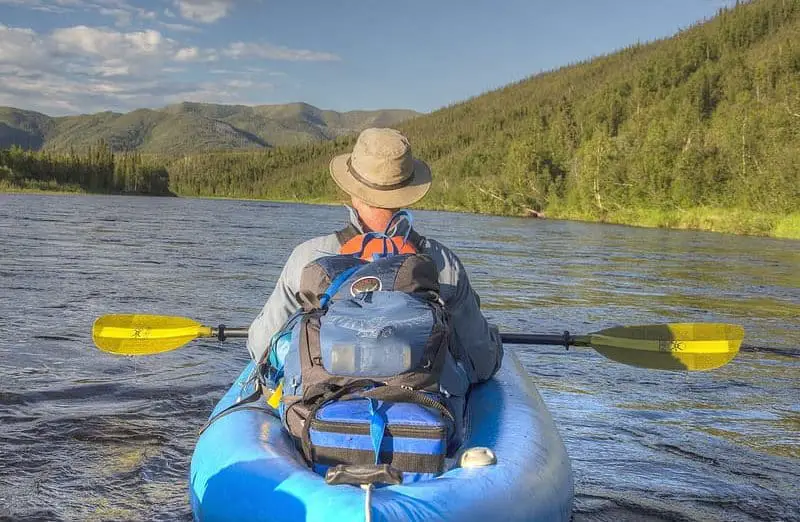
Are inflatable kayaks worth it?
Yes! A lot of people switch from hard shell kayaks to inflatable kayaks and never go back. They’re more affordable but still last for a long time when they’re well cared for, and they’re also much easier to store and transport.
It’s a good idea to look around, read reviews and the information from the manufacturer, and make sure you’re getting the best deal but for many people, inflatable kayaks are a good investment and worth the money spent.
Are inflatable kayaks good for beginners?
Yes. Inflatable kayaks are usually the best option for beginners because they’re cheaper and easier to maintain than hard shells.
You probably won’t find an inflatable kayak that you can use on long trips or for ‘serious’ kayaking, but if you’re looking for something that will be great for casual paddling and works nicely for beginners, an inflatable kayak can be perfect.
Also, if you’re just starting out you might not want to spend a lot of money on a kayak, roof rack and somewhere to safely store it. An inflatable kayak will cost less money for the boat and won’t require lots of other gear to go with it.
Can one person use a two person inflatable kayak?
Yes! One person can use a two-person kayak, regardless of whether it’s inflatable or a hard shell.
However, it’s much easier for one person to use a two-person kayak if it’s inflatable, and some inflatable two-person kayaks are designed to be used by one or two people interchangeably.
A few of the kayaks we looked at earlier are for two people but have movable and removable seats so you can use them alone and utilize the extra space for storage.
This can be perfect if you’re looking to bring a dog, children, or just a picnic when you go kayaking.
How long does an inflatable kayak last?
This really depends. Most inflatable kayaks will have a warranty, so make sure to check that before you buy and look at the company’s refund/exchange policy.
Inflatable kayaks (like everything else) last longer if they’re well cared for, so make sure that you don’t drag your kayak across hard rocks as this may damage the material, make sure that any punctures are correctly patched up, and don’t put the kayak away when it’s wet.
If you don’t have time to dry it properly when you’re out, make sure you do it when you get home. Most inflatable kayaks should last you a good number of years.
Can you put a dog in an inflatable kayak?
You could put a dog in an inflatable kayak. More importantly, you should put a dog in an inflatable kayak.
There are few things nicer than paddling down a river with your dog sitting next to you, possibly in a little captain hat, looking at the views, and enjoying each other’s company.
We’d recommend not bringing a dog the first time you use your inflatable kayak because you’ll need to get used to it, and having a dog with you could bring added stress when you’re setting up and actually getting onto the water.
You should also check that the kayak isn’t made of anything that might get damaged by your dog’s paws.
Are inflatable kayaks good for rivers?
Inflatable kayaks work best on calm waters, so slow-running rivers and lakes are ideal.
Because inflatable kayaks are extremely light and literally full of air, they tend to sit on top of the water instead of cutting through it like a hard shell kayak.
This means that they can get thrown off course or even blown over (capsize) if there’s a lot of wind or a strong current. Don’t let this discourage you: most of the best inflatable kayaks will work well on rivers, and it’s easy to spend a nice afternoon paddling around on your local river.
How tough are inflatable kayaks?
Tougher than you might expect. The idea that an inflatable kayak might pop like a cheap beach ball is pervasive but untrue: manufacturers of inflatable kayaks put a lot of effort into making sure that the plastic they use is durable and can withstand people walking on the kayaks, scraping against rocks, or underwater obstacles and general wear and tear.
Some kayaks are tougher than others, and it’s worth doing some research and reading reviews if you’re shopping online to make sure that you get a good quality inflatable kayak that will last.
Best Inflatable Kayaks – Conclusion
Inflatable kayaks are a great option for a lot of people. They’re easy to store, transport, and can be versatile and used for one or two people without having to invest in separate boats.
Since their inception manufacturers and designers have come up with lots of different ways to make inflatable kayaks, which is why we now have so much diversity and so many options for kayakers.
Although they’re often used by beginners, many experienced kayakers enjoy using inflatables and prefer them over hard shells.
Like any other big purchase, it’s important to think hard about what you want and research thoroughly before you buy.
The kayaks we’ve laid out for you are a real mix and there are options for people on larger and smaller budgets, with different experiences, and for those who like to do specific things in their kayaks, like fishing.
We hope you’ve found this useful and informative, and that you find a kayak that you love and get a lot of use out of.
Related Kayaking Posts:
- Kayak Rudder Kits: Top Picks & How-To Install
- How To Store A Kayak In A Garage – Different Options
- Best Kayak Trolling Motors: 5 Reviews & Buyers Guide (2023)
- Kayak Truck Racks – Best Options & Buyers Guide
- Best Kayak Fishing Crates For Easy Kayak Storage
- What Is A Scupper Plug & Do You Need Them In Your Kayak?
- Paddle Board VS Kayak – Which Is Best For You?
- Best Kayak Cooler For Ice Cold Storage In 2023
- Best Kayak Carts, Wheels & Trolleys You Should Use In 2025
- Intex Challenger K1 Review – Inflatable Kayak Guides

